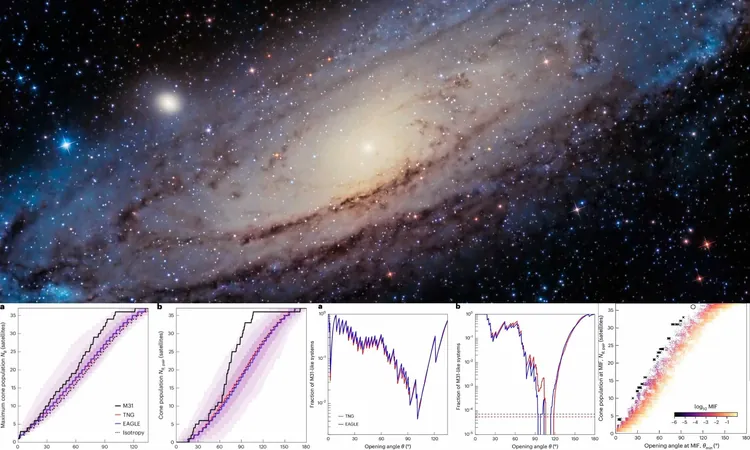
Unveiling Andromeda's Cosmic Arrow: Dwarf Galaxies Pointing to Earth
2025-05-23
Author: Yan
A Cosmic Mystery Unraveled
For generations, stargazers have marveled at the Andromeda galaxy, our cosmic neighbor located a staggering 2.5 million light-years away. Recently, astronomers have discovered an astonishing phenomenon among Andromeda's tiny companion galaxies—these dwarf galaxies appear to align in a striking formation that points directly at our own Milky Way. This unusual arrangement has left scientists both excited and puzzled.
Andromeda's Dwarfs: A Dance of Gravity
In the vast universe, larger galaxies often have smaller ones—like a dance floor of cosmic relatives—orbiting them. These tiny companions can reveal crucial details about the galaxy's formation and the gravitational forces at play. However, the dwarf galaxies of Andromeda exhibit a bewildering skew towards our galaxy, contradicting what experts anticipated when they analyzed their distribution.
An Eerie Cosmic Arrow
Astronomical observations using state-of-the-art telescopes have captured stunning images of these dwarf systems. Many are arranged in a flattened structure, akin to the orbital planes of certain planets within our solar system, raising the intrigue of how they ended up aligned in our direction.
A Rare Formation with Extraordinary Odds
Scientists conducted advanced simulations to determine the odds of such a peculiar arrangement. Shockingly, they calculated that the likelihood of these dwarf galaxies aligning as they do is less than 0.3%. Kosuke Jamie Kanehisa from the Leibniz Institute for Astrophysics has noted, 'M31 is the only system that we know of that demonstrates such an extreme degree of asymmetry.' This unusual configuration teases at deeper mysteries about cosmic evolution.
Theories Behind the Alignment
Astronomers speculate that the alignment of Andromeda's dwarf galaxies could be a result of dynamic events in the past. One theory posits that a mid-sized galaxy collided with Andromeda billions of years ago, leaving some dwarf galaxies directed toward our line of sight. Alternatively, inaccuracies in measuring their distances might mean we misinterpret their spread.
Rethinking Cosmic Structures
In standard cosmological theories, dark matter is thought to pull galaxies together, creating a random assortment of satellite galaxies. Yet, Andromeda's dwarfs defy this notion, clustering predominantly on one side, compelling scientists to reconsider established theories about how galaxies attract and accumulate their smaller companions.
What Lies Ahead: Future Investigations
Aiming to unlock more secrets, astronomers are gearing up for new surveys to detect fainter dwarf galaxies that may lurk beyond Andromeda’s edge. The next-generation telescopes promise sharper sensitivity, potentially revealing objects overlooked before. Enhanced tracking of satellite motions will also clarify whether Andromeda's dwarfs were recently disturbed or have held this orientation for millennia.
An Ongoing Quest for Answers
As astronomers dissect this cosmic anomaly, they aim to gauge whether Andromeda’s case is a unique event or if similar structures exist throughout the universe. Knowledge of this peculiar arrangement could lead to groundbreaking insights into the history of galaxies and the forces shaping them, sparking an ongoing conversation about our place in the cosmos.
Stay tuned as the universe continues to unveil its secrets—what will the next wave of discoveries reveal about the mysteries of Andromeda and beyond?


 Brasil (PT)
Brasil (PT)
 Canada (EN)
Canada (EN)
 Chile (ES)
Chile (ES)
 Česko (CS)
Česko (CS)
 대한민국 (KO)
대한민국 (KO)
 España (ES)
España (ES)
 France (FR)
France (FR)
 Hong Kong (EN)
Hong Kong (EN)
 Italia (IT)
Italia (IT)
 日本 (JA)
日本 (JA)
 Magyarország (HU)
Magyarország (HU)
 Norge (NO)
Norge (NO)
 Polska (PL)
Polska (PL)
 Schweiz (DE)
Schweiz (DE)
 Singapore (EN)
Singapore (EN)
 Sverige (SV)
Sverige (SV)
 Suomi (FI)
Suomi (FI)
 Türkiye (TR)
Türkiye (TR)
 الإمارات العربية المتحدة (AR)
الإمارات العربية المتحدة (AR)